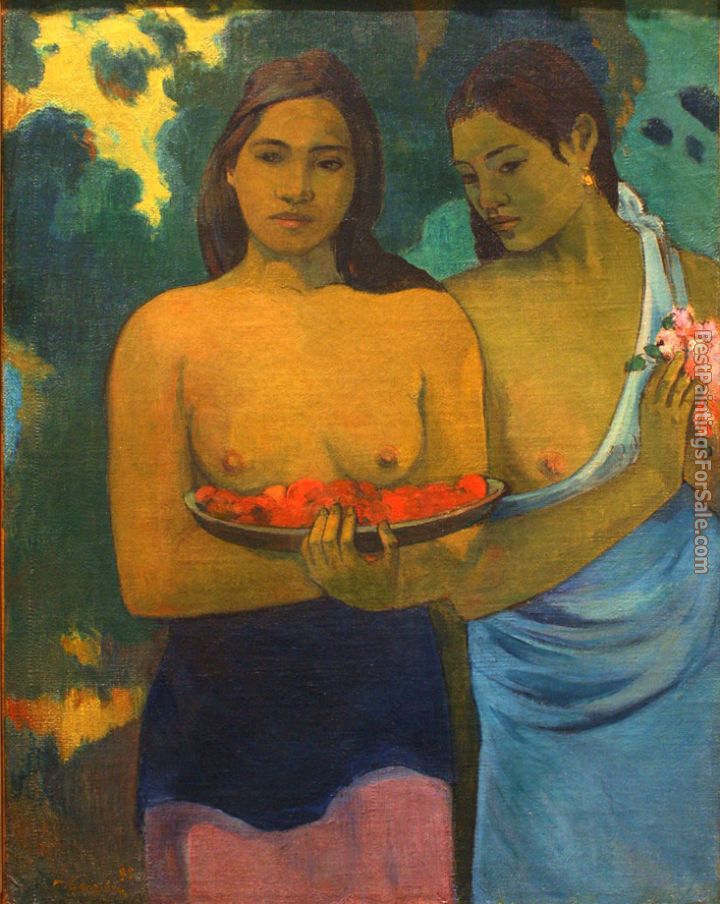Paul Gauguin Paintings for sale
Shop your favorite Paul Gauguin paintings and frames at discount price. We ship worldwide and accept custom art reproduction in any size.
oil paintings for sale > shop by artist > Paul Gauguin Paintings
- No. i9618
- Two Tahitian Women by Paul Gauguin paintings for sale
- Art price:from $98.01
- Select the size & frame

- No. i9609
- The Yellow Christ by Paul Gauguin paintings for sale
- Art price:from $98.01
- Select the size & frame

- No. i9574
- Tahitian Women On the Beach by Paul Gauguin paintings for sale
- Art price:from $98.01
- Select the size & frame

- No. i9556
- Still Life with Oranges by Paul Gauguin paintings for sale
- Art price:from $94.11
- Select the size & frame

- No. i9528
- Manao tupapau by Paul Gauguin paintings for sale
- Art price:from $98.01
- Select the size & frame

- No. i9549
- Spirit of the Dead Watching by Paul Gauguin paintings for sale
- Art price:from $98.01
- Select the size & frame

- No. i9514
- Haere Pape by Paul Gauguin paintings for sale
- Art price:from $98.01
- Select the size & frame

- No. i9639
- Tahitian Landscape by Paul Gauguin paintings for sale
- Art price:from $94.11
- Select the size & frame

- No. i9492
- Arearea by Paul Gauguin paintings for sale
- Art price:from $98.01
- Select the size & frame

- No. i9525
- Les Alyscamps by Paul Gauguin paintings for sale
- Art price:from $98.01
- Select the size & frame

- No. i9533
- Nave Nave Moe by Paul Gauguin paintings for sale
- Art price:from $98.01
- Select the size & frame

- No. i9573
- Tahitian Women Bathing by Paul Gauguin paintings for sale
- Art price:from $98.01
- Select the size & frame

- No. i9515
- Hail Mary by Paul Gauguin paintings for sale
- Art price:from $101.13
- Select the size & frame

- No. i9541
- Portrait of Vincent van Gogh Painting Sunflowers by Paul Gauguin paintings for sale
- Art price:from $98.01
- Select the size & frame

- No. i9625
- What Are You Jealous by Paul Gauguin paintings for sale
- Art price:from $98.01
- Select the size & frame

- No. i9627
- When Will You Marry by Paul Gauguin paintings for sale
- Art price:from $98.01
- Select the size & frame

- No. i9524
- Landscape with Peacocks by Paul Gauguin paintings for sale
- Art price:from $98.01
- Select the size & frame

- No. i9603
- The Siesta by Paul Gauguin paintings for sale
- Art price:from $98.01
- Select the size & frame

- No. i9561
- Still-Life with Japanese Woodcut by Paul Gauguin paintings for sale
- Art price:from $98.01
- Select the size & frame

- No. i9602
- The Seed of Areoi by Paul Gauguin paintings for sale
- Art price:from $98.01
- Select the size & frame

- No. i9630
- Where Do We Come From by Paul Gauguin paintings for sale
- Art price:from $101.13
- Select the size & frame

- No. i9575
- Tahitian Women under the Palms by Paul Gauguin paintings for sale
- Art price:from $98.01
- Select the size & frame

- No. i9606
- The Vision After the Sermon by Paul Gauguin paintings for sale
- Art price:from $101.13
- Select the size & frame

- No. i9636
- Words of the Devil by Paul Gauguin paintings for sale
- Art price:from $98.01
- Select the size & frame

- No. i9619
- Two Women on Beach by Paul Gauguin paintings for sale
- Art price:from $98.01
- Select the size & frame

- No. i9560
- Still Life with Three Puppies by Paul Gauguin paintings for sale
- Art price:from $98.01
- Select the size & frame

- No. i9590
- The Loss of Virginity by Paul Gauguin paintings for sale
- Art price:from $98.01
- Select the size & frame

- No. i9526
- Mahana No Atua by Paul Gauguin paintings for sale
- Art price:from $98.01
- Select the size & frame

- No. i9614
- Tropical Vegetation by Paul Gauguin paintings for sale
- Art price:from $94.11
- Select the size & frame

- No. i9634
- Woman with a Flower by Paul Gauguin paintings for sale
- Art price:from $98.01
- Select the size & frame

- No. i9608
- The White Horse by Paul Gauguin paintings for sale
- Art price:from $98.01
- Select the size & frame

- No. i9621
- Vase of Flowers and Window by Paul Gauguin paintings for sale
- Art price:from $98.01
- Select the size & frame

- No. i9496
- Breton Girls Dancing by Paul Gauguin
- Art price:from $98.01
- Select the size & frame

- No. i9534
- Nevermore Oh Tahiti by Paul Gauguin
- Art price:from $98.01
- Select the size & frame

- No. i9510
- Flowers in a Fruit Bowl by Paul Gauguin
- Art price:from $98.01
- Select the size & frame
Paul Gauguin (7 June 1848 - 8 May 1903) was a leading Post-Impressionist painter. His bold experimentation with coloring led directly to the Synthetist style of modern art while his expression of the inherent meaning of the subjects in his paintings, under the influence of the cloisonnist style, paved the way to Primitivism and the return to the pastoral. Paul Gauguin was also an influential exponent of wood engraving and woodcuts as art forms.
-Paul Gauguin - Post-Impressionism, Primitivism Movement
About Paul Gauguin: Paul Gauguin was born in Paris, France to journalist Clovis Gauguin and half-Peruvian Aline Maria Chazal, the daughter of proto-socialist leader Flora Tristan. In 1851 the family left Paris for Peru, motivated by the political climate of the period. Clovis died on the voyage, leaving three-year old Paul, his mother and his sister to fend for themselves. They lived for four years in Lima, Peru with Paul's uncle and his family. The imagery of Peru would later influence Paul in his art. The vogue for Paul Gauguin Paintings started soon after his death. Many of his later paintings were acquired by the Russian collector Sergei Shchukin. A substantial part of his collection is displayed in the Pushkin Museum and the Hermitage. Paul Gauguin Paintings are rarely offered for sale their price may be as high as $39.2 million US Dollars.
One of Paul Gauguin Famous Paintings
Paul Gauguin Paintings for sale - Handmade Canvas Reproductions
based on 1995 ratings.
- Shop by Art Gallery
- Gustav klimt
- Thomas Moran
- vincent van gogh
- Rembrandt Paintings
- Thomas Cole
- Thomas Kinkade paintings
- Leroy Neiman paintings
- Frank Frazetta
- Winslow Homer Paintings
- Vladimir Kush
- Fabian Perez paintings
- Michael Garmash
- Jack Vettriano paintings
- Sanford Robinson Gifford
- Vladimir Volegov
- Montague Dawson
- Amedeo Modigliani
- Maya Eventov
- Alexander Koester
- Talantbek Chekirov Paintings
- Andrew Atroshenko
- Benjamin Williams Leader
- Rudolf Ernst Paintings
- Brent Lynch
- Cassius Marcellus Coolidge
- Marc Chagall
- David Lloyd Glover
- Edward Hopper
- Emile Munier
- Edward Henry Potthast
- Flamenco Dancer paintings
- Franz Marc
- Frederick Morgan
- Francois Boucher
- George Armfield
- George Stubbs
- Henri Rousseau
- William Bradford
- thomas hill
- see more artists
new paintingsIn Stock Catalog
top selling
money back guarantee!- Vincent van Gogh The Night Cafe
- Mark Rothko Untitled Violet Black Orange Yellow on White and Red 1949
- 3d art Meditative Rose I
- Henri Matisse Goldfish
- Caravaggio Narcissus
- Albert Bierstadt On the Saco
- Franz Marc fighting forms
- Marc Chagall lovers in the red sky
- Unknown Artist Muhammad Ali
- browse more top selling
- ©2024 iPaintingsforsale.com All Right reserved.






